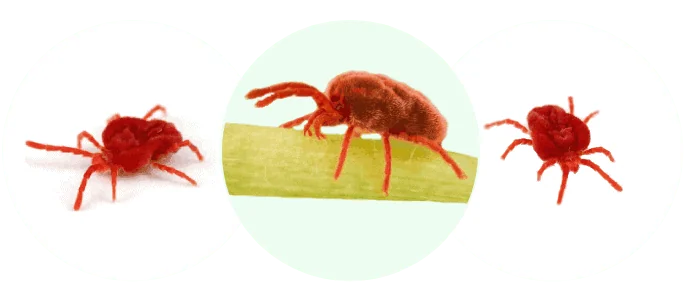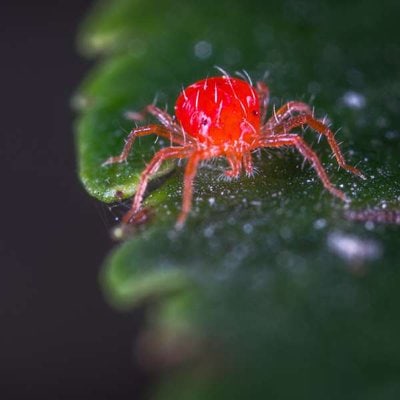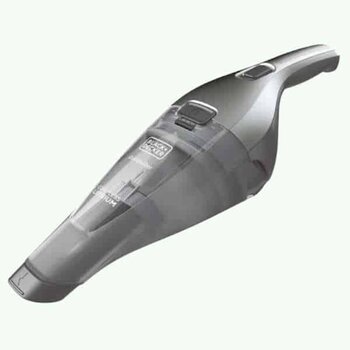A colony of bright-colored, dot-sized bugs on your bed sheets is not an everyday view. The tiny red bugs in bed are a typical fall or summer scene. Don’t get shocked by their color – they’re not here for your blood. However, sharing your bed with bugs is not an ideal situation. So let’s find out what they are and how to wave them goodbye.

Topics Explored
- What Are These Tiny Red Bugs in My Bed? »
- Are These Tiny Red Bugs in Bed Dangerous? »
- Other Bugs Commonly Confused with Clover Mites »
- How to Get Rid of Clover Mites »
- FAQs »
What Are These Tiny Red Bugs In My Bed?
These tiny red bugs in bed are clover mites. They’re 0.75 mm big(1), eight-legged, and with bright red color. They’re close relatives to ticks but feed on ornamental plants like clovers and dandelions. Clover mites move slowly and invade homes when their outdoor host plants are dried up or cut off.
Clover mites thrive at a temperature around 70℉ to 75℉(2) and invade indoor facilities when the temperature outside becomes too hot or too cold. They’re small, so they can enter your home through tiny cracks and look for a protected area, like your bed. Clover mites feast off plants, so your house plants can be their next host.

Are These Tiny Red Bugs in Bed Dangerous?
The tiny red bugs in bed don’t bite humans or pets or cause any health issues unless you’re allergic to them. But during the winter months, they can infest your home in large numbers through windows and cracks(2), causing frustration since they’re tiny and hard to remove. The only danger they carry is to your lawn – since they graze on plants, they can cause wilting or larger areas.
They Are Commonly Confused With…
It’s easy to confuse tiny red bugs in bed for bed bugs, dust mites, or other insects. Clover mites are most commonly confused with chiggers due to the same color. However, there are some telltale signs to distinguish clover mites from other more harmful bugs.
How Do I Get Rid of Clover Mites in My Bed?
So you want those tiny red bugs in bed gone. While crushing them is an easy and straightforward method, it will stain your sheets. They can’t survive very low or high temperatures, so that’s a method you can try, along with vacuuming and removing their host.
1. Vacuum Your Bed

Steps:
Vacuuming your bed is the best way to spot treat these tiny red bugs in bed without crushing them.
- Use the nozzle attachment or a hand-held vacuum for better, more precise vacuuming.
- Burn the vacuum bag or empty the vacuum’s canister away from your home. Wash it with hot water and soap to ensure the mites are gone and won’t re-infest your home.
How it Helps:
Vacuuming sucks the mites without crushing them and leaving a mark. Their legs are not strong enough to hold onto the surface, and they can’t fly, so vacuuming is easy. They hide into bed crevices and hard-to-reach places, and vacuums can suck them out
2. Freeze Them to Oblivion
Steps:
Freezing is an option for smaller and removable items like pillowcases, sheets, blankets, and curtains.
- Place the items in a tightly sealed bag so the mites won’t escape, and keep the bag in the freezer for 3 to 4 days.
- Vacuum or shake off the dead clover mites away from home. Wash your bedding in hot water to get rid of any residual eggs.

How it Helps:
Temperatures below 70°F will cause dormancy and kill adult clover mites(2). They feed off plants, and when they can’t feed for a few days, they’ll die. Clover mites can’t survive at temperatures over 102°F, so the hot water will help destroy the eggs.
3. Use Sticky Tape & Crank Up the Heat

Steps:
Heat is a great way to draw out these tiny red bugs in bed without staining your bedding and mattress.
- Remove your bedding and move the bed away from the wall.
- Place sticky tape anywhere in the pathway of clover mites. This includes the foot of the bed, the edge of the mattress, and the headboard. Ideally, you’d want to place tape in a way that blocks their escape route.
- Then expose the bedroom to sunlight and turn up the thermostat as high as it can go.
How it Helps:
Clover mites are extremely sensitive to heat and thrive in perfectly warm temperatures. When it becomes too hot, they roam to find a better place to hide. That’s when the sticky tape comes to play – they’ll get stuck while trying to escape.
4. Scatter Diatomaceous Earth
Steps:
Diatomaceous earth is a non-toxic way of pest control. Make sure you get a food-grade version that’s safe for humans and pets.
- Scatter it around the doorway of your bedroom, the foot of the bed, and any cracks where mites can enter.
- Don’t scatter it on the mattress or any materials you don’t want stained.

How it Helps:
Clover mites can’t fly; they crawl, so there’s a good chance diatomaceous can take care of them when placed in their pathway. As the mites go across the powder, it penetrates their body and lets their body fluid out. Death happens within 24 hours, though better results are usually apparent after 5 days.
5. Remove Plants & Shrubs in Close Periphery

Steps:
To get rid of these tiny red bugs in bed in its entirety, stop clover mites from entering your bedroom and house in the first place.
- Remove plants that are near your windows and entryways as they can be hosts to clover mites, which can later make their way inside through cracks, gaps, and vents.
- It’s best to leave an 18 to 24 inches plant-free band around the perimeter of your home(1).
- Treat the ‘band’ with boric acid or diatomaceous earth to stop them from entering your home.
How it Helps:
Removing the plants prevents clover mites from infesting areas nearest to your home, even if they have invaded your garden. The band or ‘moat’ serves as a buffer that prevents mites from entering your home.
Summary: Tiny Red Bugs in Bed
Dealing with tiny red bugs in bed starts with their proper identification. When you identify them correctly, you can choose the suitable method that gets rid of them. When it comes to clover mites, removing them is not complex as they are not a threat to humans and pets, and you can smash them, but they easily stain your bedding, which is not what you’d want.

FAQs:
Do bed bugs look like tiny red specks?
Bed bugs are dark red and brown. They can look like red specks on your bed and leave red marks on your bedding after a blood meal. If they’re vibrant red in color and don’t bite, they’re not bed bugs but clover mites. Clover mites are not a serious threat to your health unlike bed bugs.
Do clover mites bite?
Clover mites feed on ornamental plants like clovers – hence their name. They don’t bite humans or animals but can cause a skin reaction if you’re allergic or sensitive. They represent a more serious threat to your garden and house plants which as a result turn brown and then wilt.
Will clover mites go away?
Clover mites feed on plants, and grass and when they’re indoors where there’s a lack of vegetation, they’ll eventually starve to death. They’re also known to die of dehydration within a few days. The lifespan of an adult clover mite is 3 weeks to a month, so they’ll only last for that long.
Verified Sources:
- University of Florida https://entnemdept.ufl.edu/creatures/orn/mites/clover_mite.htm
- Kuvin Center for the Study of Infectious and Tropical Diseases: https://www.researchgate.net/publication/316516990_The_clover_mite_Bryobia_praetiosa
- US EPA: https://www.epa.gov/bedbugs/bed-bugs-appearance-and-life-cycle
- Missouri Department of Conservation: https://mdc.mo.gov/discover-nature/field-guide/chiggers

